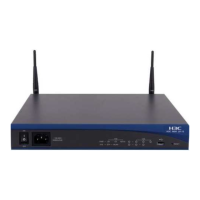3.3.4 Configuring the Peer Mode
This part describes how to configure the NTP peer mode. In this mode, clocks on the two peers
synchronize with each other. Each side can send the clock synchronization request message to
the peer and reply the clock synchronization request message from the peer.
Procedure
l Configuring the NTP Symmetric Active End
1. Run:
system-view
The system view is displayed.
2. (Optional) Run:
ntp-service source-interface interface-type interface-number [ vpn-
instance vpn-instance-name ]
The local source interface that sends NTP packets is specified.
3. Run:
ntp-service unicast-peer ip-address [ version number | authentication-
keyid key-id | source-interface interface-type interface-number | vpn-
instance vpn-instance-name | preference ] *
The NTP peer is configured.
Step 2 is optional. If source-interface is specified in both Step 2 and Step 3, use the
source interface specified in Step 3 preferentially.
ip-address is the IP address of the NTP peer. It can be the IP address of a host address
rather than a broadcast address, a multicast address, or the IP address of the reference
clock.
NOTE
After the NTP peer is specified, the local switch runs in symmetric active mode. The symmetric
passive end need not be configured.
l (Optional) Configuring the Source Interface of the NTP Symmetric Passive End
1. Run:
system-view
The system view is displayed.
2. Run:
ntp-service source-interface interface-type interface-number
The local source interface that sends NTP packets is specified.
Commonly, specify the IP address of the NTP server on the client. The client and
server can then exchange NTP packets using this IP address
If the source interface to send NTP packets is specified on the symmetric active end,
the IP address of the NTP peer configured on the symmetric passive end should be
the same; otherwise, the passive end cannot process NTP packets sent from the active
end and clock synchronization fails.
----End
Quidway S9300 Terabit Routing Switch
Configuration Guide - Network Management 3 NTP Configuration
Issue 03 (2010-09-20) Huawei Proprietary and Confidential
Copyright © Huawei Technologies Co., Ltd.
3-9

